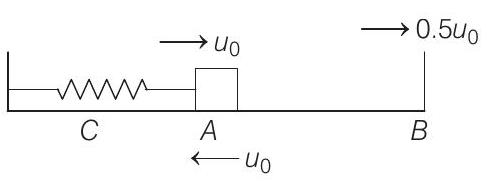Simple Harmonic Motion Ques 35
- A particle of mass $m$ is attached to one end of a massless spring of force constant $k$, lying on a frictionless horizontal plane. The other end of the spring is fixed. The particle starts moving horizontally from its equilibrium position at time $t=0$ with an initial velocity $u _0$. When the speed of the particle is $0.5$ $u _0$, it collides elastically with a rigid wall. After this collision
(2013 Adv.)
(a) the speed of the particle when it returns to its equilibrium position is $u _0$
(b) the time at which the particle passes through the equilibrium position for the first time is $t=\pi \sqrt{\frac{m}{k}}$
(c) the time at which the maximum compression of the spring occurs is $t=\frac{4 \pi}{3} \sqrt{\frac{m}{k}}$
(d) the time at which the particle passes through the equilibrium position for the second time is $t=\frac{5 \pi}{3} \sqrt{\frac{m}{k}}$
Show Answer
Answer:
Correct Answer: 35.(a, d)
Solution:
Formula:
- At equilibrium $(t=0)$ particle has maximum velocity $u _0$.
Therefore velocity at time $t$ can be written as
$\quad u=u _{\max } \cos \omega t+u _0 \cos \omega$
writing, $\quad u=0.5 u _0 = u _0 \cos \omega t$

$ \begin{aligned} & \therefore & \omega t & =\frac{\pi}{3} \\ & \therefore & \frac{2 \pi}{T} t & =\frac{\pi}{3} \\ & \therefore & t & =\frac{T}{6} \end{aligned} $
(b) $t=t _{A B}+t _{B A}=\frac{T}{6}+\frac{T}{6}=\frac{T}{3}=\frac{2 \pi}{3} \sqrt{\frac{m}{k}}$
(c) $t=t _{A B}+t _{B A}+t _{A C}=\frac{T}{6}+\frac{T}{6}+\frac{T}{4}=\frac{7}{12} T=\frac{7 \pi}{6} \sqrt{\frac{m}{k}}$
(d) $t=t _{A B}+t _{B A}+t _{A C}+t _{C A}=\frac{t}{6}+\frac{T}{6}+\frac{T}{4}+\frac{T}{4}=\frac{5}{6} T$
$ =\frac{5 \pi}{3} \sqrt{\frac{m}{k}} $





